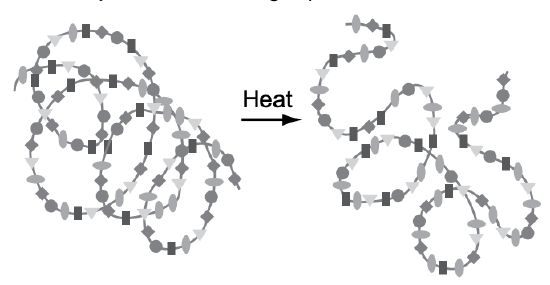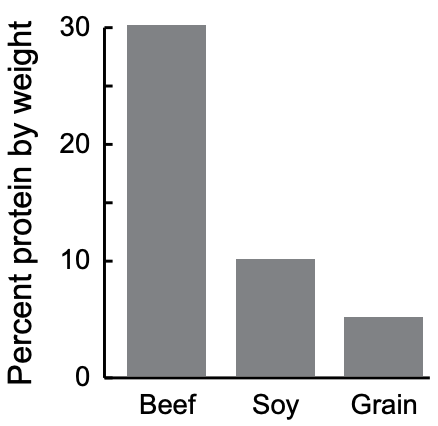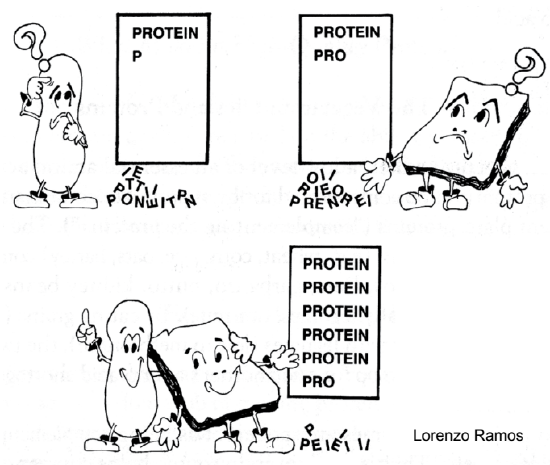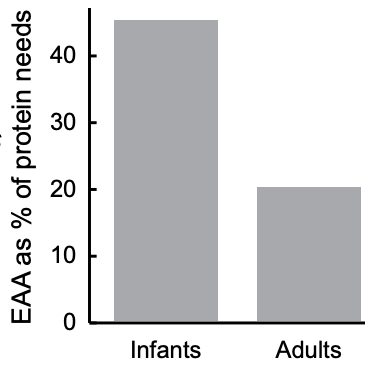6.6: The Proteins in Our Food
- Page ID
- 56975
Evaluating food sources of protein involves looking at the quantity (amount) of protein in the food as well as its quality—how well the amino acid composition of the protein meets our needs. Animal foods are generally higher in both quantity and quality of protein than plant foods (see Fig. 6-5).
A 3-oz. portion of chicken meat has 27 grams of protein, whereas a cup of refried beans (weighing over 3 times as much—10 oz.) has 18 grams of protein. And of at least equal importance, the amino acid composition of chicken protein is of higher quality—it’s more in line with what we need.
What Makes a High-Quality Protein?
Since the need for protein is actually a need for amino acids, differences in protein quality are based on the ability of foods to supply amino acids in something like the proportions of the body’s needs. The key to that quality is how well it supplies one group of 9 amino acids, those which are called essential amino acids (see Table 6-1).

Essential Amino Acids
At first glance, this may seem puzzling. For the body must have all 20 amino acids to do its job of making protein. Why then, are some amino acids “essential” while others are not?
The answer is quite simple. It’s that 11 of the 20 amino acids can be made by the body (as long as the body has enough nitrogen, the characterizing element of proteins). These amino acids are available to the cells as long as a sufficient amount of protein is consumed, no matter what its origin and amino acid composition. They are thus called non-essential amino acids because they aren’t required in the diet.
The nine that can’t be made by the body are called essential amino acids because they are required in the diet. If we don’t eat foods with enough of these nine amino acids, the body can’t make the proteins it needs. We require adequate intakes of these amino acids, just as we require adequate intakes of specific vitamins and minerals.
The quality of a dietary protein refers to its proportions of essential amino acids, relative to our own needs. As might be expected, animal proteins are the highest in quality, since the amino acid composition of these proteins more closely reflect that of our own proteins. The proteins found in our muscles, blood, and organs certainly resemble proteins from a chicken or cow more than proteins from beans or corn.
Plant proteins vary in quality, with soybean protein near the top, and wheat and corn proteins near the bottom. Plant proteins can, however, be combined to improve their quality. All natural proteins (plant and animal) have some amount of all 20 amino acids. The critical question is whether the total diet has a sufficient amount of each of the essential amino acids.
Egg protein is the gold standard by which other proteins are measured. Its high quality isn’t surprising—it represents the compact package of nutrients needed to produce a bird.
The essential amino acid in shortest supply (relative to need) is called the limiting amino acid, because it limits protein production. Since all 20 amino acids are needed to make protein, the amount of protein that can be made is limited if there isn’t enough of just one amino acid.
The Vegetarian Diet and Proteins
In a vegetarian diet, a low level of an essential amino acid in a plant protein can be compensated for by appropriate combinations of different plant proteins—complementing the proteins. The classic example is that of grains (e.g., wheat, corn, rice, oats, barley) combined with legumes (e.g., soy, lima, garbanzo, pinto, kidney beans—and peanuts, which are really legumes, not nuts).
By eating grains (low in the amino acid lysine—the limiting amino acid in grain) with legumes (low in methionine—the limiting amino acid in legumes), the two protein sources help make up for one another’s amino acid shortages (see Fig. 6-6).
So grains and legumes are spoken of as being complementary in terms of protein. That is, each protein source helps compensate for the amino acid shortage of the other.
Oftentimes, quantity can make up for quality. If a single plant food that’s a fairly rich source of protein is eaten in sufficient amount, there may be enough of even a low-level amino acid. In such a case, complementing plant proteins may not be necessary. For example, even though wheat protein doesn’t have much of the essential amino acid lysine, a diet which includes enough wheat can supply enough lysine.

This was demonstrated in an experiment in which subjects were fed a diet which depended for most of its protein on eight slices of bread at each meal. Within a few weeks, it could be shown that the subjects were receiving adequate amino acids, even though wheat is low in lysine.
The problem is that where one food becomes an overwhelmingly large part of the diet, there’s always a risk that one or more vital nutrients will not be adequately supplied. A basic tenet of good nutrition is to eat a variety of foods.
In any event, many people throughout the world don’t have the luxury of eating the large amounts of plant protein needed to meet their amino acid needs. In some cases, technology has come to the rescue. A large segment of the population of Tunisia was given wheat which was enriched with additional lysine. Also, a serious problem of protein malnutrition among the children of Hong Kong was alleviated by the addition of methionine to a soy milk.
Many people throughout history have survived well on wholly vegetarian diets—plant proteins were combined “properly” long before the discovery of amino acids (see Table 6-2). Traditional combinations, of grains and legumes are tortillas and beans, tofu (soybean curd) and rice, baked beans and bread, falafel (chickpeas/ garbanzo beans in pita bread), and the old American standby—a peanut butter sandwich (see Fig. 6-6).

Legumes and seeds (e.g., sesame, pumpkin, sunflower) also make a good combination, as in the middle-eastern dish hummus, a combination of chickpeas and sesame seeds. In a modern twist, Japanese researchers envisioned creating “rice-tofu” by biotechnology—transferring the genes for soybean protein into rice.2
How Much Protein in the Food?
In addition to the need for sufficient sources of the essential amino acids, there’s a need for an amount of protein in general, to supply—or for the body to make—the non-essential amino acids. In this respect, it’s the total amount (quantity) of protein in the food rather than its essential amino acid composition (quality) that must be considered.
As noted earlier, quantity and quality tend to be related, in that foods with the highest quality protein generally have the most protein. Cooked portions of lean beef, chicken, and fish have about 30% protein by weight, soy beans about 10%, and grains about 5% or less (see Fig. 6-5).
Diets that regularly contain animal protein are usually more than adequate in terms of meeting needs for both essential amino acids and total protein. In this country, about two-thirds of the protein in the overall diet comes from animal sources.3 As might be expected, the amount—and quality)—of protein in the “typical American diet” far exceeds our requirements.
| Combine legumes with: |
|
kale |
| Combine grain or corn with: |
|
fresh lima beans |
| Combine potatoes with: |
|
spinach |
Table 6-2: Complementary Plant Proteins
Proteins from Plant and Animal Foods
It follows from what’s been said that the amount of protein needed in the diet is higher when the protein comes exclusively or primarily from plants. More is needed because of differences in quality, but also because of differences in digestibility. Animal proteins are about 95% digestible, proteins in refined grains are about 90-95% digestible, and proteins in whole grains, beans, and vegetables are about 80-85% digestible.4 These small differences in digestibility are significant in diets that provide marginal amounts of protein.
Because of its high quality, animal sources of protein are particularly valuable to growing children. For infants, the need for essential amino acids makes up about 45% of their protein requirement because of an infant’s rapid growth (addition of body tissue), whereas the proportion for adults is only about 20% (see Fig. 6-7).
Essential amino acids make up a greater proportion of animal protein than of plant protein, and, therefore, animal proteins are better suited to meet an infant’s needs. It’s no coincidence that breast milk is an infant’s first and best food. A mother’s milk is an easily digested, rich combination of nutrients (including essential amino acids) tailor-made for a baby.
Growing children not only need high-quality protein but, as mentioned earlier, need large amounts of protein in proportion to their body weight. They also need more calories in proportion to body weight. Animal sources of protein are not only more concentrated in protein than plant sources, but also provide more fat—a concentrated source of the calories needed by a growing child.

Strict vegetarian (vegan—no animal foods) diets thus aren’t generally well-suited for young children. But, as we shall see in the Guest Lecture at the end of this chapter and in the next chapter, vegetarian diets can work well for adults.)
To get a better understanding of our need for dietary protein, we must know something of how the body uses the amino acids once they have been absorbed. This understanding can enable us to choose this most costly part of our food with wisdom, with economy, and with the realistic knowledge of how these foods can support good health.


